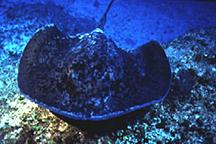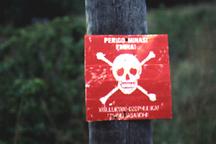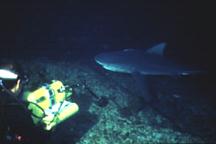![]()
|
Diving With the Sharks of Mozambiqueby Al Hornsby |
|
| |
As we bump along a sandy track in our four-wheel drive vehicle toward the coast of Mozambique, the essence and flavor of the Africa we've always imagined is proved real. An expansive, wild land extends into the distance in all directions. Grass-thatch roofed huts and dark, smiling faces line the road where settlements occur. Clear air and the quiet of country in its natural state surrounds us.
We've passed through game reserves where monkeys, rhinos, hippos, antelope and fish eagles gazed at us cautiously. Thrilled at our contact with nature's bounty, we know we have even more excitement ahead, just offshore from the village of Ponta do Ouro, where on one small reef pinnacle there is a huge collection of sharks - bulls, tigers, silvertips, and hammerheads.
And, unexpectedly, in this process of discovery, we also will find ourselves touched by the poignancy of human lives existing in a country struggling back from 20 years of civil war, bloodshed, and destruction. Mozambique, now a quiet, peaceful place, still shows its scars - abandoned houses, bullet riddled walls, telephone poles without wire, and warning signs that mines still lay hidden off the beaten paths.
We arrive in Ponta do Ouro on a sunny, hot day. After crossing the miles of scrub-covered dunes that line the eastern coast of South Africa and Mozambique, we look down on a beautiful, broad bay and a blue ocean furrowed with long, slow waves from over the horizon.

Once a thriving, beach vacation destination, the village is now still, as if waiting for change. Once luxurious, Portuguese-style villas sit vacant and empty around the hillsides overlooking the bay. A few vehicles move about, and local people, as we've seen throughout our travel in Africa, walk everywhere, the women balancing huge loads - water cans, firewood, tubs of laundry - on their heads, seemingly without effort.
But like new seedlings bursting through the charred floor of a burned forest, new life is springing up, here and there. The old hotel, the Motel de Mar, has been reopened and is undergoing refurbishing. A resort and camp at Ponta do Ouro, the home of African Watersports, our dive hosts, has also been reopened and is again bringing visitors into this beautiful, haunted place.
The range of emotions that ran through us as we contemplated this situation, so completely outside our own sheltered experience, put us in a reflective mood as we prepared for our first dive in Mozambique. Soon enough, however, the diving made its own impression, and changed our reflection to something else - to pure excitement, as we entered a world that was wild and totally untamed.
The warm, Indian Ocean waters here are rich, and burstingly full of life. With all the strata of the food chain healthy and profuse, the diving is a constant interaction with fish-life of every description. Unpolluted waters filled with planktonic and embryonic creatures feed swarms of baitfish; the>
l range of game fish. In our few days of diving we saw tuna, jacks, kingfish, barracuda and one six-foot long sailfish.

Near the bottom, schools of blue striped snappers and numerous huge potato cod milled about. Marbled rays scoured the bottom and on one dive, a huge - and unusual - honeycomb moray extended straight up from his hideaway, slowly swaying to some unknown rhythm of his own. With all of this, the next predator level was predictable - sharks. We dived one site on all of our dives; there was simply no reason to go anyplace else. A spot known as the Pinnacles is a coral mound some four miles out to sea that rises up to a depth of about 125 feet. The numbers and variety of sharks there was astounding. In all our dives we were constantly surrounded by eight to nine foot long silvertips and bull sharks (known as Zambezi sharks in these waters). A lone, great hammerhead appeared on the scene during one dive, and we all kept a watchful eye for a 15 foot long tiger shark that is seen every week or so, cruising unhurriedly through what surely must be his own personal domain. We weren't lucky enough to have the rare opportunity to see and photograph this majestic creature, but just the thought of the perhaps was enough to fill us with excitement...
Our most adrenalin-filled dive was our last dive of the trip, at sunset, near Pinnacles, in a gray, rolling ocean. This, we all knew, was the "witching hour" for shark dives, a time of day when feeding activity would reach its crescendo.
Light was already fading as we entered the water. We went to the bottom, at 125 feet, for a planned decompression dive. Our guide suspended a fish from a line into our midst as bait. Within moments, two large bull sharks and a silvertip were on the scene, circling, moving close.
In most shark feeds, the sharks are interested in the fish, and largely ignore the divers in the water. These sharks were different. They knew we were there. They cared. They let us know.
They would move in closer, closer, then too close, requiring a sharp bump with a strobe to push them away. My dive buddies, Peter and Steph Lamberti, two of South Africa's best known underwater photographers and film-makers, and I repeatedly exchanged looks - "Wow! Did you see that?

A big bull, over eight feet long, came toward Peter. Movie lights lit the scene brightly. As my flash went off, the bull rushed and smacked headlong into Peter's housed Sony digital betacam. He turned and rushed again - bang! Then a third time; on this approach, recorded on Peter's tape, his mouth opened wide for a grating, scraping bite against the aluminum housing.
As our bottom time ended, we moved upward to our deco stop, the last rays of the sunset slanting through the surging water. The two bull sharks came with us, circling, coming under us, then swinging back to pass closely over our heads.
For the next twenty minutes we viewed these huge, impressive sharks at close range. Seldom seen in areas frequented by American divers, these sharks are known to be bold and aggressive, and everything about them confirmed that reputation. Their bulk, their huge mouths - which seemed to hinge nearly back to their gill slits - and their obvious intense interest in prey, clearly communicated predator in the truest sense of the word.
Finally, air gone, film spent, we began climbing back into our inflatable in the near darkness. Our last look at our bulls was them milling about under our boat as we began to pull away - they stayed, curious and interested - predators - until the very end..
As we headed toward shore, our diving finished, the last of the faded
suns et's orange and pink glow spread
across the African sky. The wind blew spume from wave tops into the clear air. We sat
quietly, each of us bathed in thoughts and memory. We all knew we had witnessed and
experienced something special in these last few days, something rare that touched us
deeply. We knew we could never forget; the place, the people, the thrilling diving with
the majestic sharks, of a marvelous, distant land called Mozambique.
et's orange and pink glow spread
across the African sky. The wind blew spume from wave tops into the clear air. We sat
quietly, each of us bathed in thoughts and memory. We all knew we had witnessed and
experienced something special in these last few days, something rare that touched us
deeply. We knew we could never forget; the place, the people, the thrilling diving with
the majestic sharks, of a marvelous, distant land called Mozambique.